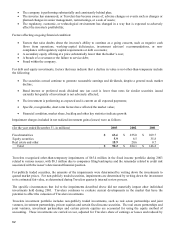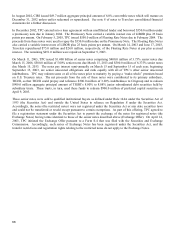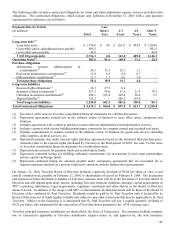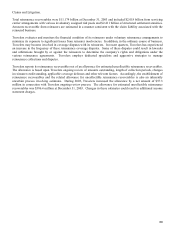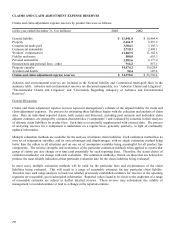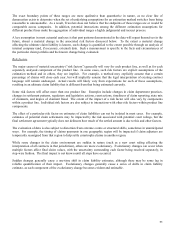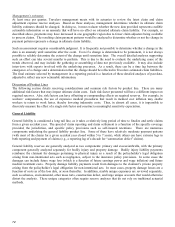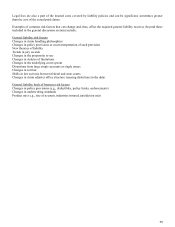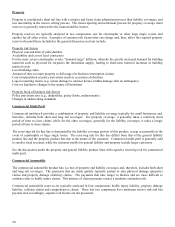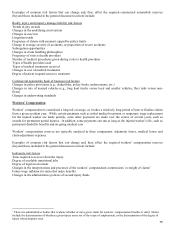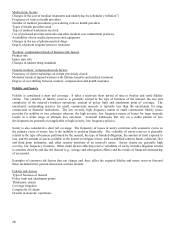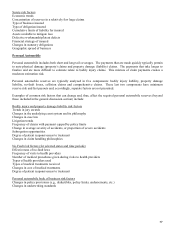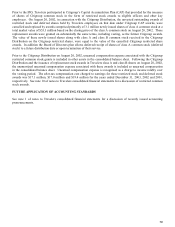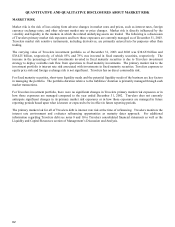Travelers 2003 Annual Report Download - page 74
Download and view the complete annual report
Please find page 74 of the 2003 Travelers annual report below. You can navigate through the pages in the report by either clicking on the pages listed below, or by using the keyword search tool below to find specific information within the annual report.
72
Management’s estimates
At least once per quarter, Travelers management meets with its actuaries to review the latest claim and claim
adjustment expense reserve analyses. Based on these analyses, management determines whether its ultimate claim
liability estimates should be changed. In doing so, it must evaluate whether the new data provided represents credible
actionable information or an anomaly that will have no effect on estimated ultimate claim liability. For example, as
described above, payments may have decreased in one geographic region due to fewer claim adjusters being available
to process claims. The resulting claim payment patterns would be analyzed to determine whether or not the change in
payment pattern represents a change in ultimate claim liability.
Such an assessment requires considerable judgment. It is frequently not possible to determine whether a change in the
data is an anomaly until sometime after the event. Even if a change is determined to be permanent, it is not always
possible to reliably determine the extent of the change until sometime later. The overall detailed analyses supporting
such an effort can take several months to perform. This is due to the need to evaluate the underlying cause of the
trends observed, and may include the gathering or assembling of data not previously available. It may also include
interviews with experts involved with the underlying processes. As a result, there can be a time lag between the
emergence of a change and a determination that the change should be reflected in Travelers estimated claim liabilities.
The final estimate selected by management in a reporting period is a function of these detailed analyses of past data,
adjusted to reflect any new actionable information.
Discussion of Product Lines
The following section details reserving considerations and common risk factors by product line. There are many
additional risk factors that may impact ultimate claim costs. Each risk factor presented will have a different impact on
required reserves. Also, risk factors can have offsetting or compounding effects on required reserves. For example, in
workers’ compensation, the use of expensive medical procedures that result in medical cost inflation may enable
workers to return to work faster, thereby lowering indemnity costs. Thus, in almost all cases, it is impossible to
discretely measure the effect of a single risk factor and construct a meaningful sensitivity expectation.
General Liability
General liability is considered a long tail line, as it takes a relatively long period of time to finalize and settle claims
from a given accident year. The speed of claim reporting and claim settlement is a function of the specific coverage
provided, the jurisdiction, and specific policy provisions such as self-insured retentions. There are numerous
components underlying the general liability product line. Some of these have relatively moderate payment patterns
(with most of the claims for a given accident year closed within 5 to 7 years), while others can have extreme lags in
both reporting and payment of claims (e.g., a reporting lag of a decade for “construction defect” claims).
General liability reserves are generally analyzed as two components: primary and excess/umbrella, with the primary
component generally analyzed separately for bodily injury and property damage. Bodily injury liability payments
reimburse the claimant for damages pertaining to physical injury as a result of the policyholder’s legal obligation
arising from non-intentional acts such as negligence, subject to the insurance policy provisions. In some cases the
damages can include future wage loss (which is a function of future earnings power and wage inflation) and future
medical treatment costs. Property damage liability payments result from damages to the claimant’s private property
arising from the policyholder’s legal obligation for non-intentional acts. In most cases, property damage losses are a
function of costs as of the loss date, or soon thereafter. In addition, sizable unique exposures are reviewed separately,
such as asbestos, environmental, other mass torts, construction defect, and large unique accounts that would otherwise
distort the analysis. These unique categories often require reserve analyses that do not rely on traditional actuarial
methods.


